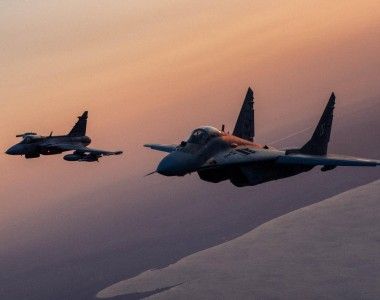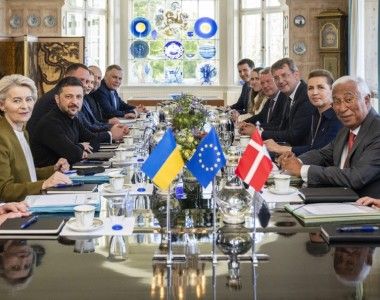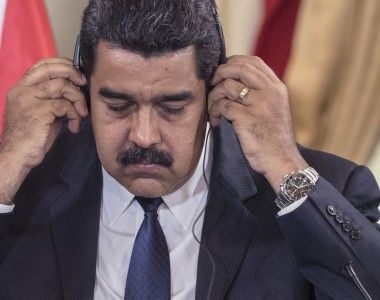Brig. Gen. Mokrzycki: We must recognize the importance of large-scale military operations

Photo. Zespół Reporterski - 2 Korpus Polski-2 Polish Corps (Facebook)
On the sidelines of the 2nd Territorial Defense Symposium in Krakow, Defence24 editors had the opportunity to talk to the Chief of Staff of the 2nd Polish Corps. Brig. Gen. Jarosław Mokrzycki spoke about the importance of the Territorial Defense Forces in terms of NATO’s eastern flank, but also about the cooperation between the 2nd Polish Corps and the US Army V Corps and the importance the 2nd Polish Corps itself plays in defense planning. There were also references to experiences and lessons learned about observations of events on the frontlines of the war in Ukraine. The head of Defence24’s analysis department, Jacek Raubo, conducted the interview.
Jacek Raubo (Defence24) - General, at the outset, I would like to thank you for the opportunity to talk to you. At the outset, I would like to ask why, from the perspective of the overall system of defense of NATO’s eastern flank, territorial defense in the countries of the region is so important. And why should we discuss it, if only in the format proposed by the two Corps in Krakow as part of the 2nd Symposium?
Brig. Gen. Jarosław Mokrzycki (2nd Polish Corps) - In our region, territorial defense is a component of national defense systems, which should be tied together like bricks in a wall through operational standardization and NATO interoperability. By consciously building an allied defense mechanism for NATO’s eastern flank in the land domain, the more we connect the various national elements, the stronger the defense system we will create. From the perspective of the NATO higher commands, it is, above all, the combat-capable corps, or corps commands, together with their subordinate armies, that constitute the combat power of the defense structure. Thus, the corps commands, which are regionally oriented, create defense plans in specific regions using all available resources, including territorial defense forces, which often escape allied standardization, and, of course, by lumping them together, they ensure that the plans are mutually consistent. This activity, carried out by national and allied higher commands, integrates the operating armed forces of NATO countries in our region into one coherent system in a mechanism of containment, deterrence, and, if that is ineffective, a mechanism of combat.

We had this Symposium of Territorial Defense Forces from different countries. So, is our region standardizing its approach to territorial defense? For example, can we still speak of a particular specificity regarding doctrine and strategy in Poland and the Baltic States?
Looking at it from a regional perspective, the operational context, including allied regional planning, is essential. It is not the case that we have only Polish, Czech, or Lithuanian operational objectives of armed combat. When we analyze planned defense operations through the perspective of combat functions such as, for example, surveillance, fires, command, or logistical security of forces, we aim to improve the combined way of fighting, paying attention to the terrain, infrastructure structure, and channels of operational maneuver more than to national borders. Sitting down at the same table, all of us who are making these plans have to ask ourselves: How do we make maximum, efficient use of available resources? Thus, if Territorial Defense Forces, which have different origins and different purposes in the countries of our region, are to be used effectively not only in a national but also in an allied operation, they often slip out of NATO standards and out of our perception in operational planning.
Read more
It is necessary to learn well what these forces are in Lithuania, what they are in Estonia, Latvia, Poland, the Czech Republic, in Romania in order to be able to plan them properly for use. Our meetings aim to understand national specifics regarding the capabilities and use of territorial defense forces rather than standardizing them in the region. However, I would not rule out such a process in the future. Today, territorial defense forces are different national solutions, differently constructed, with different purposes. Suppose we need to understand these differences better. In that case, those interested in using Territorial Defense capabilities in the rear zone of operations and the zone of direct operations will be unable to effectively use tens of thousands of soldiers of this type of Armed Forces service branch.
General, now let me ask a question regarding these two days of discussions during the Symposium. What was achieved, and, in fact, what do these types of meetings contribute to the planning and development of the Polish Territorial Defense Force’s potential?
I have already partly answered this question earlier. We have been discussing the use of the TDF way just before or during the conduct of war since the beginning of their appearance in the structure of the Polish Armed Forces. It is not a search for an answer to how, but how to do it better. This approach is evolving and, at the same time, varies from army to army. However, we recognize that it must be consistent enough to consider the possible needs of multinational joint operations. The Territorial Defense Forces - when, for example, we look from the American perspective in Poland - can perform both an auxiliary function for the 2nd Polish Corps performing the tasks of the Land Component Command in a defensive operation on the territory of Poland and at the same time support the US Army V Corps, which is also stationed in Poland, in their operations.
For the allied corps commands, it is no longer so obvious how the Polish Territorial Defense Forces can carry out this support and how identical forces, such as the Lithuanian, Estonian, or Latvian Armed Forces, can carry out these tasks.
Read more
The content of the symposiums, the first and the second, was, on the one hand, the effective use of those capabilities of the territorial defense forces that are already achieved, and on the other hand, the search for solutions over support in building more. Here, we are talking about air and artillery coordination, the use of UAVs, battle damage assessment, evacuation of the wounded, support for the protection and defense of forces, etc., in all combat functions. These capabilities are structured and standardized in the operational armies of the countries in our region, but differences are emerging in the territorial defense forces. We work on solutions during our meetings, and the first successes emerge.
General, in this case, I would like to ask whether the Territorial Defense Forces occupy an important place in the creation of the Polish II Corps« potential. Often, it is precisely the territorial defense that is indicated as an additional element, somewhere thrown in from the side, and as I hear, it is an important force multiplier, as the Americans often say.
Territorial Defense Forces in our national system have a heterogeneous purpose. They played a significant role in peacetime and pre-war times. They relieve the burden on operational forces and provide freedom of deployment, which is vital in maneuver operations. Among other things, the use of the TDF allows us to do multi-domain planning, making the TDF truly a force multiplier. They carry out tasks differently in the zone of direct operations and will play a completely different role in the rear zone of operations. And precisely because these are different tasks, we will increasingly push these troops to have diversified equipment and prepare differently to support operational troops. Today, we are designing a way of using brigades scattered across the country with similar capabilities tomorrow. Hopefully, we will better align these capabilities with operational requirements that align with the brigades« wartime purpose, considering that we may go beyond the Polish area as part of allied operations. Nevertheless, our primary responsibility of the 2nd Corps - Land Component Command will be, first and foremost, the defense of the Republic of Poland and the eastern flank of NATO, and such tasks in our grouping and not »on the side« are performed by TDF.
Read more
General, now I would like to move on to this day and the relationship with the US Army V Corps. In general, how can you characterize this cooperation? What is vital in this relationship? What key challenges can we speak of today vis-à-vis this relationship?
The US V Corps and the Polish 2 Corps Command are strictly national. It is probably why our thread of understanding is so strong. At the same time, although they are not part of the NATO force structure, they both train intensively with the corps commands of the Alliance. It has implications, of course, which translate into how we use, prepare, and, before that, train the personnel of our commands. The US V Corps uses technology that is very close to us at the moment. Because of the arrangement of the Polish Armed Forces« acquisition plan and the characteristics of the equipment that are just entering the array, the American soldiers are a mine of knowledge for us. Looking at this in advance, we are preparing our staff and people to use this potential most effectively.
Read more
I am talking, of course, about deep fires, targeting, the use of Army Aviation and rocket artillery, and the way information is managed, which is crucial, mainly when it is a large-scale multi-corps operation, which is what we are dealing with because the smaller ones are not relevant at all to the opposing side. So, if there were a situation of armed conflict that went beyond the mark of a hybrid operation, then the fight would not just be fought by a single corps group of forces, but on a ground scale in our theatre, it would have to be a multi-corps group. It is a fundamental challenge for us - interoperability and the ability to fight in the land domain in an international group comprised of multiple national and allied corps structures.
General, Poland is probably unique in that we have Szczecin and the Multinational North-East Corps there, Poznań with the US Army V Corps, and Kraków with the 2nd Polish Corps. So, in essence, we are a bit of a NATO laboratory, looking from the perspective of the development of just this corps level. Is this something surprising?
It is not surprising if we consider what I said earlier. In this direction, if a conventional conflict were to occur, it would be pretty high in scale and would have to be conducted in such a way that the opposing side would assume tactical effects that would be measurably beneficial on a larger operational and strategic scale. We understand this and are preparing to deter such action from a potential adversary. Here, I am talking directly about Russia.
Read more
General, I want to move on to something crucial, to the stage that the 2nd Polish Corps is actually at today. What can we say about the preparation of our Corps today? In the statement of Lieutenant General Charles Costanza, the commander of V Corps, I heard that you are already ready. What does it look like right now?
It is true. General Costanza praised our preparation and performance in Exercise Avenger Triad 24, which USAREUR Command recognized as the largest NATO exercise since 1986. This computer-assisted command post exercise, which aimed, among other things, to verify new CIS solutions, improve interoperability, and demonstrate USAREUR-AF’s ability to command combined US and NATO forces, was carried out by Command Posts deployed at various locations across Europe. The US command, exercising its role as the Combined and Allied Land Component Command in the theatre of operations, testing the ability to command the US Corps and five NATO Corps created unique conditions for the participating 2nd Polish Corps to test procedures and capabilities to execute actions during simulated large-scale and intense combat operations. While planning and conducting combat, we performed our task equally to the other corps, and the allies highly appreciated this.
General, and as if to conclude, I wanted to ask you about 2025. To what extent will it be a landmark year for the 2nd Polish Corps?
For us, this will be an important year. It will be the moment when we formally confirm that we are ready to conduct military operations on our national territory. Based on the NATO CREVAL procedures approved by the NATO Allied Command Operations, a team designated by the Chief of the General Staff of the Polish Armed Forces will assess our command’s capabilities, confirming the readiness of the 2nd Corps—Land Component Command to operate as intended.
Read more
How has Ukraine influenced the question of the importance of the corps level? I have read many studies, e.g., on C2, and it is just indicated that this Ukrainian experience will be very much influenced by C2 and C4.
On a different scale in Ukraine, the war with Russia has been going on continuously since 2014. It is a very long period. During this time, the Russian side has not achieved its stated strategic goals, or, on the contrary, assuming that the strategic goal is to wage war itself and destroy the Ukrainian state, it is still achieving them. And if so, that would mean that this particular war is not the best example of a high-scale conflict. Unreflectively taking into account the lessons that the Ukrainian side is currently gathering and collecting would be counter-productive for the Polish Armed Forces. The conditions of warfare in Ukraine and Poland are entirely different. The political conditions are different, the state’s military strength is different, and the allied relations and the solutions for the exchange of information in the systems with which we support the processes in the individual combat functions are different. They are directly integrated into NATO. It makes no sense to treat them separately. Our decision support, reconnaissance, or missile process mechanisms are allied-integrated.
Read more
All this has an impact on the corps« combat capability. However, the observations and lessons generated at lower tactical levels do not need to be considered, e.g., the methods of using UAVs as integrators of reconnaissance and fire functions from the battalion level and below. There is a lot of catching up to do here. Because of my previous position as Commander of LITPOLUKRBRIG, I got to know many commanders of Ukrainian battalions and brigades who today perform tasks at the level of brigades and higher commands. We are in contact with people who, on the Ukrainian side, plan at our level, i.e., the operational-tactical command of the group of forces (Оперативно-тактичне угрупуваннe військ) - the Ukrainian equivalent of the corps command. We draw on their experience. I am tempted to say that this indirectly influences the processes and products produced at 2nd Corps Command, but fundamentally, we are guided by the requirements of building allied interoperability.
General, Thank you very much for the interview.










